Physical Address
304 North Cardinal St.
Dorchester Center, MA 02124
Hereditary motor and sensory neuropathies (HMSNs) are a group of genetically acquired progressive peripheral neuropathies ( Boxes 34.1 and 34.2 ). The most common of this group is Charcot-Marie-Tooth disease, described by the team of Charcot and Marie and, independently, by Tooth, in 1886. Dyck and Lambert classified the HMSNs in 1968 ( Table 34.1 ).
The predominant involvement is of peripheral motor neurons, with lesser involvement of peripheral sensory and peripheral autonomic neurons.
The disorders are inherited.
The disorders are slowly progressive.
The neurologic signs are symmetric.
The disorders are system degenerations in that several populations of neurons of similar structure and function are affected.
The pathologic features are nonfocal, and nerve fiber degeneration consists of axonal atrophy and degeneration.
Charcot-Marie-Tooth (CMT)—Most prevalent neuromuscular disease in children
Dijerine-Sottas syndrome—infantile form of inherited neuropathy
CMT in two types—demyelinating and axonal
Greater than 80 Charcot-Marie-Tooth genes now identified
PMP22 duplication most frequent cause of CMT
Foot and hip most common orthopaedic problems
| Type | Example |
|---|---|
| HMSN I | Charcot-Marie-Tooth disease (hypertrophic demyelinating type) |
| HMSN II | Charcot-Marie-Tooth disease (axonal type) |
| HMSN III | Dejerine-Sottas disease |
| HMSN IV | Refsum disease |
| HMSN V | Spastic paraplegia |
| HMSN VI | Similar to type I, with optic atrophy |
| HMSN VII | Similar to type I, with retinitis pigmentosa |
Charcot-Marie-Tooth disease (CMT) has classically been divided into demyelinating and axonal forms. Although types 1A, 1B, and 1C are characterized by demyelination and type 2 by axonal degeneration, studies have established intermediate forms such as type C and X-linked CMT, suggesting a continuum of disease encompassing demyelination and axonal degeneration. Studies have indicated that demyelination renders the axon susceptible to degeneration, which may explain the overlap between what were traditionally considered demyelinating and axonal forms.
CMT disease type 1 (CMT-1), also known as HSMN I and II, is the most common heritable chronic demyelinating neuropathy. The overall incidence of the various forms of CMT ranges from 1/2500 to 1/5000. , The disease is characterized by progressive weakness and atrophy of distal musculature, depressed tendon reflexes, slowed motor nerve conduction velocity, and, frequently, a family history of the disorder. CMT-1 usually manifests in the second decade of life, but it may become evident earlier in some patients.
CMT disease type 2 comprises a group of peripheral neuropathies that are inherited as an autosomal dominant or recessive disorder. Although CMT-1 is generally described as a demyelinating process, CMT-2 is characterized by axonal degeneration. It is characterized by older age at onset (usually in the third decade) and normal to only slightly diminished nerve conduction velocities, but severely reduced compound motor action potentials. Deep tendon reflexes are preserved. The prevalence of CMT-2 is approximately one third that of CMT-1.
Although CMT-2 is clinically indistinguishable from CMT-1, it is pathologically and genetically distinct from CMT-1. , , One form of CMT-2 maps to chromosome 1p36, which encodes for MPZ (CMT-2A), another maps to chromosome 3p (CMT-2B), and another maps to chromosome 7p (CMT-2D) ( Table 34.2 ). , , Unlike in CMT-1, there is no enlargement of the peripheral nerves and sensory changes are infrequent. Nerve biopsy does not show hypertrophy; rather, axonal degeneration is seen. The orthopaedic manifestations of the disease are the same as those seen in CMT-1.
| Type | Genes and Loci | Features | Inheritance |
|---|---|---|---|
| 1A | PMP22 (peripheral myelin protein); 17p11.2 duplication | Most common form (70%); demyelinating | Autosomal dominant |
| 1B | MPZ or P0 (myelin protein zero); chromosome 1 point deletion | Less common (>10% of CMT1) | Autosomal dominant |
| 1C | SIMPLE gene, 16p13.1-p12.3; early growth response 2 gene | Demyelinating | Autosomal dominant |
| 2 | 2a, chromosome 1 2b, chromosome 3 2c, chromosome 7 2d, chromosome 7 2e, chromosome 8 LMNA gene—encodes for lamin A/C |
Axonal | Autosomal dominant and recessive forms |
| C | Chromosome 1p34-p35 | Intermediate; axonal and demyelinating features | Autosomal dominant |
| 4 | Chromosome 5; periaxin gene (PRX) ; SBF2; GDAP1 gene (8q21) | Outfolding of myelin sheaths; can be associated with glaucoma; axonal or demyelinating; usually early onset | Autosomal recessive |
| X | Connexin32 (CX32) gene X chromosome |
Second most common form (7%–10%); abnormal gap junction communication; intermediate slowing of nerve conduction velocities; demyelinating and axonal features; boys more severely affected | X-linked dominant |
An explosion in the number of CMT subtypes has occurred as a result of localization of their different genetic abnormalities (see Table 34.2 ). , , CMT 1, the autosomal dominant demyelinating type, is the most common type accounting for 70% of all inherited neuropathies. This classic type is caused by a duplication of the peripheral myelin protein 22 gene (PMP22) on chromosome 17p11.2. Myelin protein 22 is a glycoprotein expressed in the myelin sheath of Schwann cells. a
a References , , , , , .
This duplication causes overexpression of the PMP22 gene producing a toxic protein that overloads the protein degradation process leading to demyelination. Demyelination results in decreased nerve conduction velocity, which especially affects motor function. The neuropathy in CMT is length dependent, such that the longest nerves are the most affected. This explains the finding that the earliest findings are distal muscle weakness and atrophy.
CMT type 2, the axonal form, is caused by mutations in the mitofusin 2 (MFN2) gene. Clinically similar to CMT type 1, type 2 is often more progressive with more pronounced sensory loss. Nerve conduction velocities are not altered in type 2.
Another subtype, X-linked CMT neuropathy (CMTX) is inherited as an autosomal dominant trait. , ,
Although the specific genetic defects responsible for CMT have become known, there is little correlation between genotype and phenotype, as evidenced by the variability seen in the clinical features among affected family members. The Inherited Peripheral Neuropathies Mutation Database (IPNMDB) provides a comprehensive and updated database of all known mutations. Prenatal diagnosis using molecular genetic techniques is now available but has led to ethical debates regarding the use of prenatal genetic screening for nonlethal diseases. , ,
The age of onset varies in CMT, with some patients presenting before 5 years of age and others in adulthood. Physical examination in infants and young children with CMT proved by genetic analysis may be normal. Motor milestones are usually achieved at normal ages in those with most forms of CMT. Some younger children present with toe walking, delayed walking, and tripping and falling; however, most present in the second decade of life. Common complaints include slow running, ankle injuries, and clumsiness in sports; however, it is not uncommon to see children who are successful athletes in spite of obvious foot deformities. Boys and girls are affected in equal numbers, although boys with CMTX are more significantly involved than girls, who may be asymptomatic.
Physical examination reveals diminished-to-absent deep tendon reflexes, with the ankle reflex disappearing before the knee reflex. Sensory loss occurs in two thirds of affected individuals but is rarely noticed by the patients themselves. There may be palpable enlargement of the peripheral nerves. Motor testing results vary among patients but usually include diminished strength in the anterior tibialis and peroneus brevis. Tibialis anterior weakness can be identified by the inability to stand on the heels. As the patient actively tries to dorsiflex the ankle, the metatarsophalangeal (MTP) joints of the toes extend, and the great toe may dorsiflex to augment the weak anterior tibialis. Some patients have weakness throughout all the distal calf musculature, and those with the most severe involvement have generalized muscle weakness and are unable to walk. Atrophy of the calves can be seen in severely involved individuals, giving a so-called stork’s leg appearance ( Fig. 34.1 ). Foot deformity such as pes cavus, pes cavovarus, or claw toes is very common. Calluses along the lateral border of the foot, particularly over the base of the fifth metatarsal, may be present.
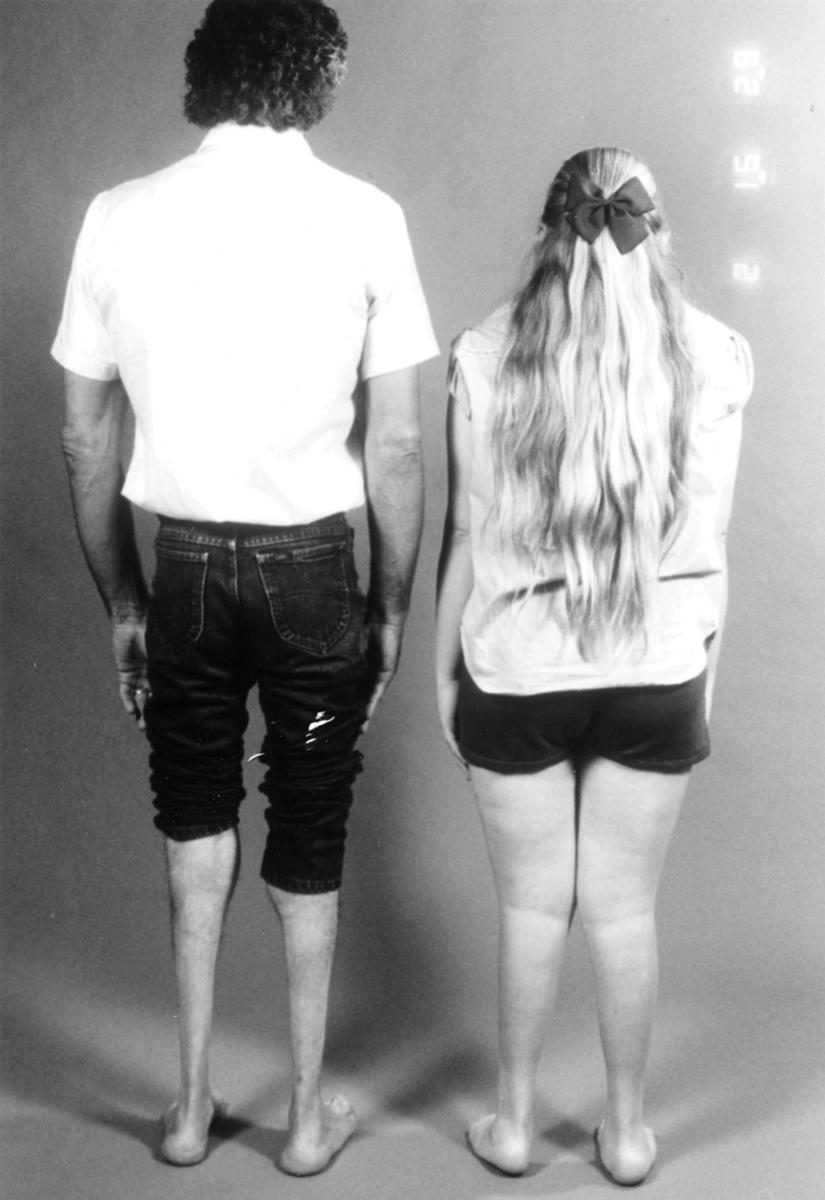
Observation of the gait in patients with early CMT reveals a subtle drop foot in swing phase. As the dorsiflexors become weaker, a steppage gait develops, characterized by plantar flexion of the ankle, hyperflexion of the knee, and hyperflexion of the hip in swing phase. Often, the hemipelvis also elevates during swing phase to allow clearance of the foot, and the leg may circumduct. Other characteristics of gait in patients with types I and II CMT include failure of plantar flexion and increased foot supination, hyperextension instance, excessive external rotation of the hip, and decreased hip adduction in stance (typical of a broad-based gait).
Examination of the hand reveals intrinsic atrophy. The patient may have difficulty grasping a goniometer placed between the fingers.
A careful examination of the spine should be performed. Although CMT is the most common cause of pes cavus, a spinal cord lesion such as a tethered cord or lipomeningocele may manifest initially with pes cavus or cavovarus. The back should be examined for evidence of underlying spinal dysraphism, such as a hairy patch, dimpling, or hemangioma. Scoliosis may be seen in teenagers with CMT but is not seen in young children; therefore, any sign of abnormal curvature in a young child should be further evaluated with magnetic resonance imaging (MRI).
Central nervous system involvement such as sensorineural deafness has been described in a few patients with the X-linked dominant form of the disease. Regardless of the type and severity of CMT, the disorder has been shown to affect the quality of life in childhood negatively, with affected children exhibiting lower physical, psychological, and social well-being than the general pediatric population.
Up to 80% to 90% of all patients with CMT can now be diagnosed with only a blood test for the known gene mutations. , Patients who are suspected of having CMT should be referred to a neurologist for further diagnostic testing. Electromyography (EMG) and the measurement of nerve conduction velocities can support the diagnosis in questionable cases. In demyelinating forms of CMT, electrophysiologic testing reveals slowing of motor nerve conduction velocities in the upper and lower extremities because of the loss of myelin ( Fig. 34.2 ). Conduction is slowed uniformly from side to side and between different motor nerves. In demyelinating forms of the disease, slowed nerve conduction velocities are present by 3 years of age, although symptoms may not be apparent. EMG may show fibrillation caused by denervation.

In occasional patients, the diagnosis remains in question after electrical studies and genetic testing, and a nerve biopsy should be performed for definitive diagnosis. The sural nerve is chosen as the site of biopsy. A 1.5-cm-long segment of nerve is removed in the interval between the posterolateral border of the Achilles tendon and lateral malleolus. The nerve lies together with the lesser saphenous vein, and the two structures should not be confused when the surgeon is obtaining the biopsy specimen. Histopathologic study of sural nerve biopsy specimens from patients with CMT-1 reveals large onion bulb formations resulting from cycles of demyelination and remyelination. The myelin appears folded or uncompacted on ultrastructural examination. There is less demyelination and fewer onion bulbs in CMTX than in classic CMT-1. Muscle biopsy in CMT-1 shows scattered atrophic fibers and neuropathic degeneration.
MRI and computed tomography (CT) of the spine show diffuse enlargement of the cauda equina, nerve roots, and ganglia. , , A difference in the location of fatty infiltration of muscles on MRI has been identified between CMT-1A and CMT-2A; patients with CMT-1A have selective fatty infiltration primarily in the anterior and lateral compartment (peroneal nerve innervated) musculature, whereas those with CMT-2A have involvement primarily of the superficial posterior compartment muscles.
Neuropathic pain is a significant problem for many people with CMT. In one study, 71% of patients who participated stated that they had neuropathic pain, most frequently in the lower back, knees, and feet. The pain may be severe enough to require treatment with medication.
There is no proven medical treatment for the various forms of CMT. Animal models have been developed, and progesterone antagonists and antioxidants, such as vitamin C, coenzyme Q, and lipoic acid, have been under investigation. , With further delineation of the molecular genetic defects responsible for CMT, treatment with gene transfer may be feasible in the future.
The most common orthopaedic manifestation of CMT is pes cavovarus. , , One study has found that patients with bilateral cavovarus feet have a 78% probability of being diagnosed with CMT; a family history of CMT increases the probability to 91%. Patients often present initially to the orthopaedic surgeon for evaluation of pes cavovarus, and the diagnostic workup leads to the diagnosis of CMT. Atrophy and contracture of the intrinsic musculature of the foot occur because of denervation, which leads to collagen replacement of the intrinsic muscles of the foot. There is an increase in the connective tissue within and around the muscle tissue. These pathologic changes produce elevation of the longitudinal arch because of contracture of the plantar fascia, which increases the pressure on the metatarsal heads and leads to painful calluses along the lateral border of the foot and beneath the metatarsal heads ( Fig. 34.3 ). Varus of the hindfoot is caused initially by the plantar flexion of the first ray and forefoot equinus. In addition, the posterior tibialis and peroneus longus remain strong relative to the weak peroneus brevis and anterior tibialis, leading to depression of the first ray and increased varus. , It is believed that the peroneus longus remains relatively stronger than the peroneus brevis because it is normally approximately twice as strong as the brevis. Toe deformity results from nonfunctional intrinsic muscles, which normally flex the MTP joints and extend the distal and proximal interphalangeal (IP) joints of the foot. With absent intrinsic function, the long toe flexors create flexion deformities of the IP joints of the toes, and the toes eventually hyperextend through the MTP joints, assuming a dorsally displaced position with metatarsal head prominence on the plantar aspect of the foot.
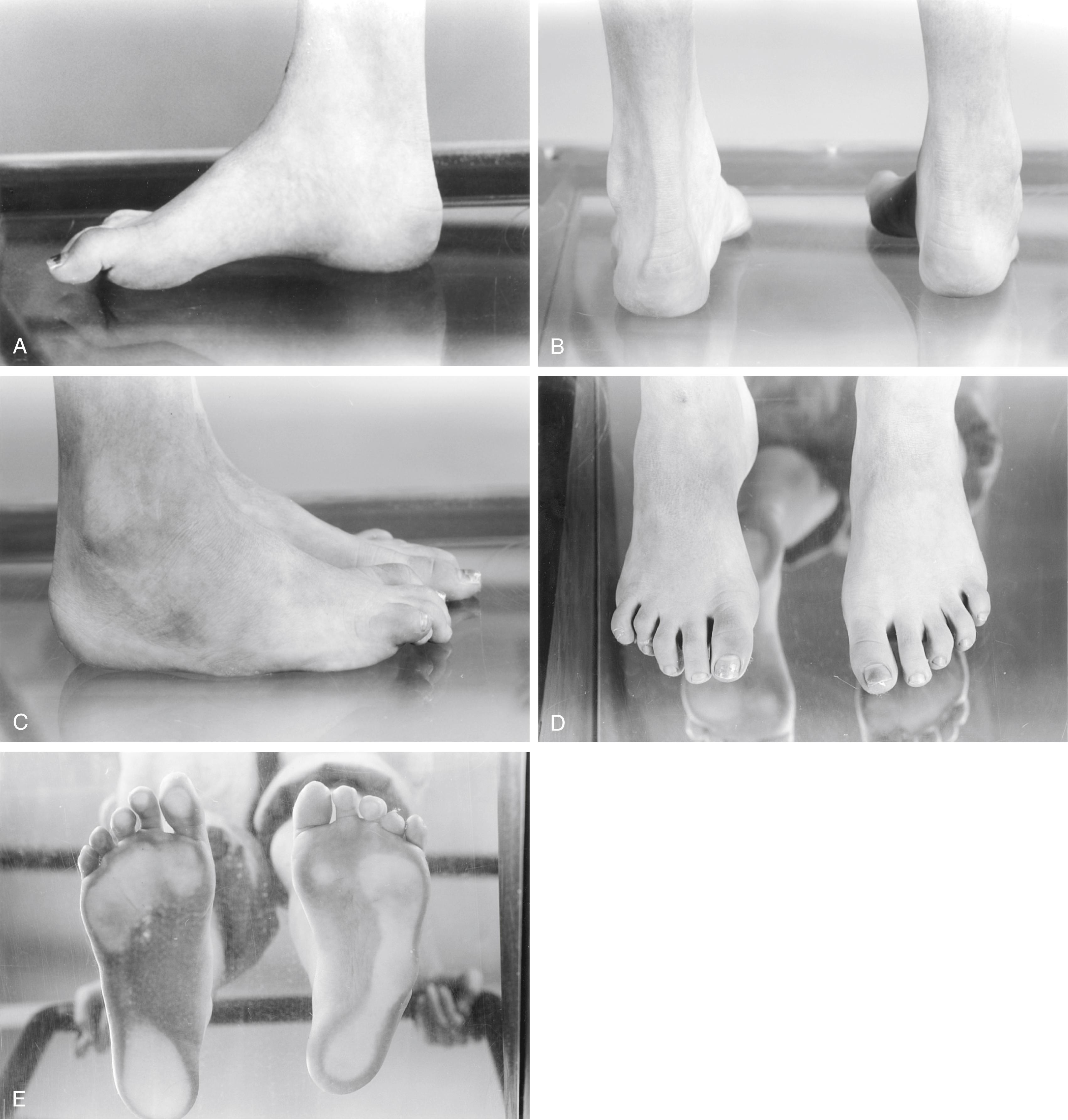
A study of adults with CMT found that foot and ankle weakness caused the greatest impact on their quality of life.
Standing lateral radiographs of the cavus foot in patients with CMT show an increase in the Meary angle, measured along the longitudinal axis of the talus and first metatarsal. Normal values for the Meary angle range from 0 to 5 degrees, but values average 18 degrees in patients with CMT. Varus is seen as parallelism of the talus and calcaneus on the lateral radiograph. Finally, the lack of hindfoot equinus can be documented by measurement of the calcaneal pitch, which usually reveals dorsiflexion of the calcaneus and the presence of forefoot equinus with the apex of the deformity in the midfoot ( Fig. 34.4 ).
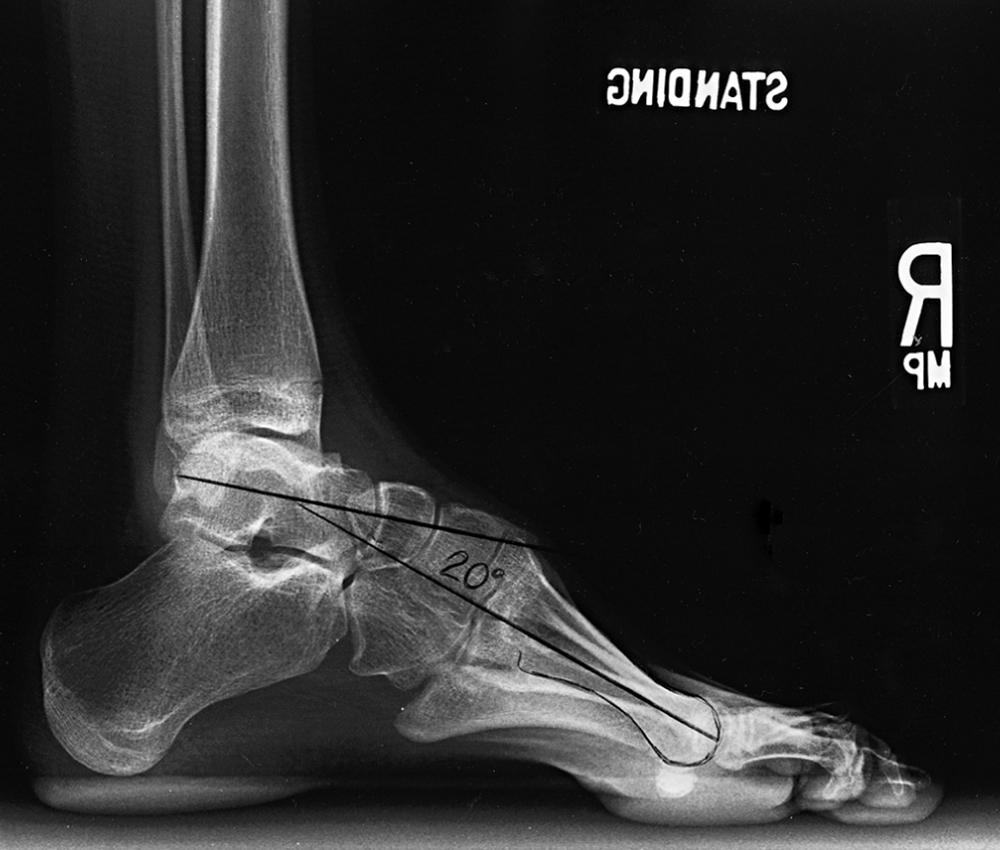
Azmaipairashvili and colleagues have described the Coleman block lateral radiograph, a mediolateral weight-bearing view for evaluating the flexibility of the hindfoot, rotational correction in the ankle, and degree of correction of forefoot supination. To obtain this view, the patient stands on a 2-inch block of radiolucent material, allowing the first, second, and third rays to drop down on the edge of the block, as in the Coleman block test. The x-ray plate is placed on the lateral side of the foot and the beam is directed from medial to lateral. The authors suggested that this radiographic view could help delineate the need for a midfoot osteotomy versus soft tissue surgery alone to correct a cavovarus foot deformity.
MRI studies have found that the appearance of fatty infiltration differs according to the severity of CMT-1A, ranging from fatty infiltration of only the intrinsic foot muscles to fatty infiltration of the lateral, anterior, and superficial posterior leg muscles; these MRI features correlated with the severity of symptoms.
The treatment of pes cavovarus foot is described in greater detail in Chapter 19 . The Coleman block test, performed by having the patient stand on a block with the head of the first metatarsal hanging medially off the block, is useful when planning surgical correction of the foot deformity. When hindfoot varus is caused by plantar flexion of the first metatarsal, the heel will evert to neutral as the first metatarsal head drops off the block and is allowed to plantar flex ( Fig. 34.5 ). With time, the varus deformity becomes fixed and does not correct when the block test is performed.
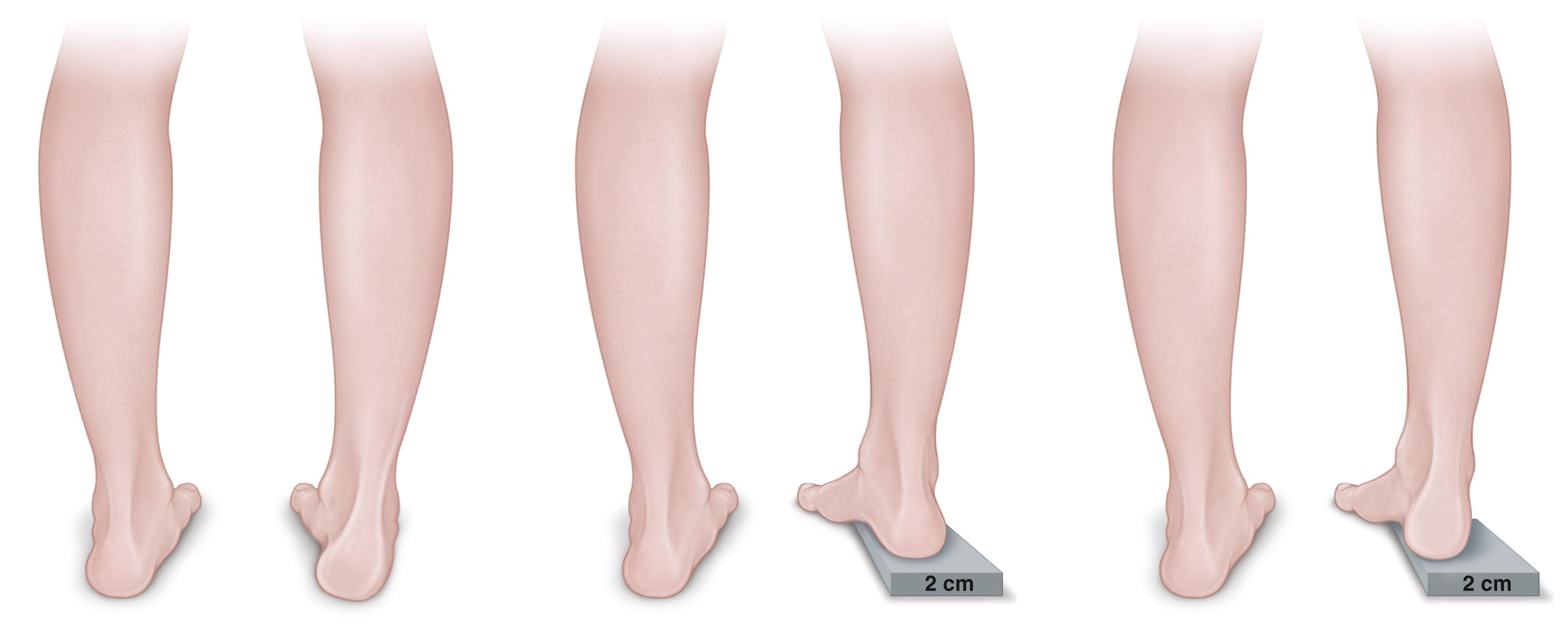
The surgical correction of the cavovarus foot in patients with CMT can be divided into two components—deformity correction and rebalancing of deforming muscle forces ( Boxes 34.3 and 34.4 ). When done early in the disease in young patients, soft tissue surgery consisting of plantar fascia release or extensive plantar release, including capsulotomies with tendon transfer, may be sufficient to postpone or avoid triple arthrodesis. b
b References , , , , , , , , .
Tibialis anterior weaker than peroneus longus → planar flexion of the first ray
Tibialis posterior stronger than peroneus brevis → hind-foot varus
Toe extensors stronger than foot intrinsics → clawing of toes
Transfer peroneus longus to brevis
Osteotomy to elevate first ray
Lengthen or transfer of tibialis posterior
Plantar fascia release
+ clawing of toes → Jones transfers
+ stiff deformity of hind-foot → calcaneal osteotomy
+ stiff deformity mid foot → mid-foot osteotomy
Dynamic pedobarography has shown that operative treatment, even when the foot deformity is corrected, may not correct abnormal foot pressure patterns, especially increased heel pressure, which was correlated with a decrease in ankle power generation. , These residual abnormal pressure patterns may cause persistence of symptoms, and the patient and parent(s) should be informed of this before surgery.
Gait analysis studies have noted several patterns of abnormality in children and adolescents with CMT. One study divided the findings into three groups: Group 1 patients had no difficulty heel or toe walking, and near-normal gait patterns; group 2 patients had difficulty heel walking and gait analysis showed foot drop; and group 3 patients had both difficulty toe and heel walking, and analysis showed increased peak dorsiflexion and reduced ankle power generation.
Tendon transfers used in CMT include transfer of the posterior tibialis tendon to the dorsum of the foot and transfer of the peroneus longus to the peroneus brevis to decrease the plantar flexion of the first ray. The anterior tibialis tendon is not transferred because it is usually weak in this disease. Proximal metatarsal osteotomy of the first metatarsal alone or of multiple metatarsals corrects plantar flexion of the forefoot in patients who have flexible varus hindfeet. , , , , Care must be taken when performing a proximal first metatarsal osteotomy in a young patient because the open physis is located proximally.
Transfer of the posterior tibialis tendon through the interosseous membrane to the dorsum of the foot may be performed to decrease hindfoot varus and provide ankle dorsiflexion. Weakness of the tibialis anterior leads to a steppage gait and foot drop during swing phase in patients with CMT. Although the posterior tibialis is considered a stance phase muscle, transfer of the posterior tibialis has been performed in this patient population with some success (see Plate 35.1).
When fixed cavovarus deformities are present, bony surgery, such as calcaneal osteotomy, midfoot dorsal closing wedge, or dome osteotomy, is recommended ( Figs. 34.6 and 34.7 ). , Although triple arthrodesis has been discouraged in patients with CMT, it may be preferable to midfoot osteotomy, which can lead to arthrosis because of the need to cross multiple joints with the osteotomy. In severe deformity, a triple arthrodesis may be necessary to restore a plantigrade foot ( Fig. 34.8 ). Careful planning of wedges to be resected during the triple arthrodesis is necessary to correct the complex hindfoot and midfoot deformities because the lack of normal protective sensation may lead to poor results over time if residual deformity persists.
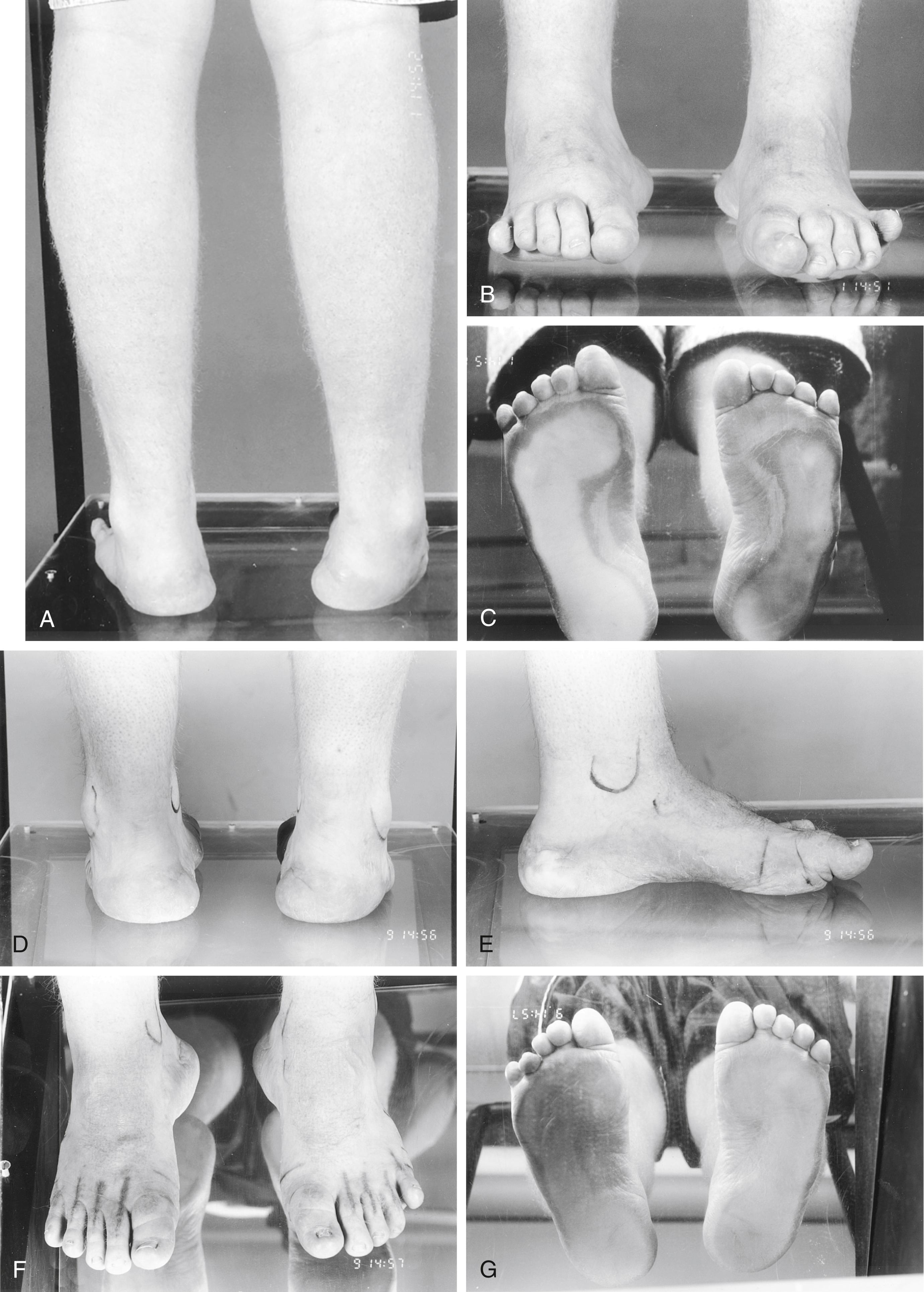
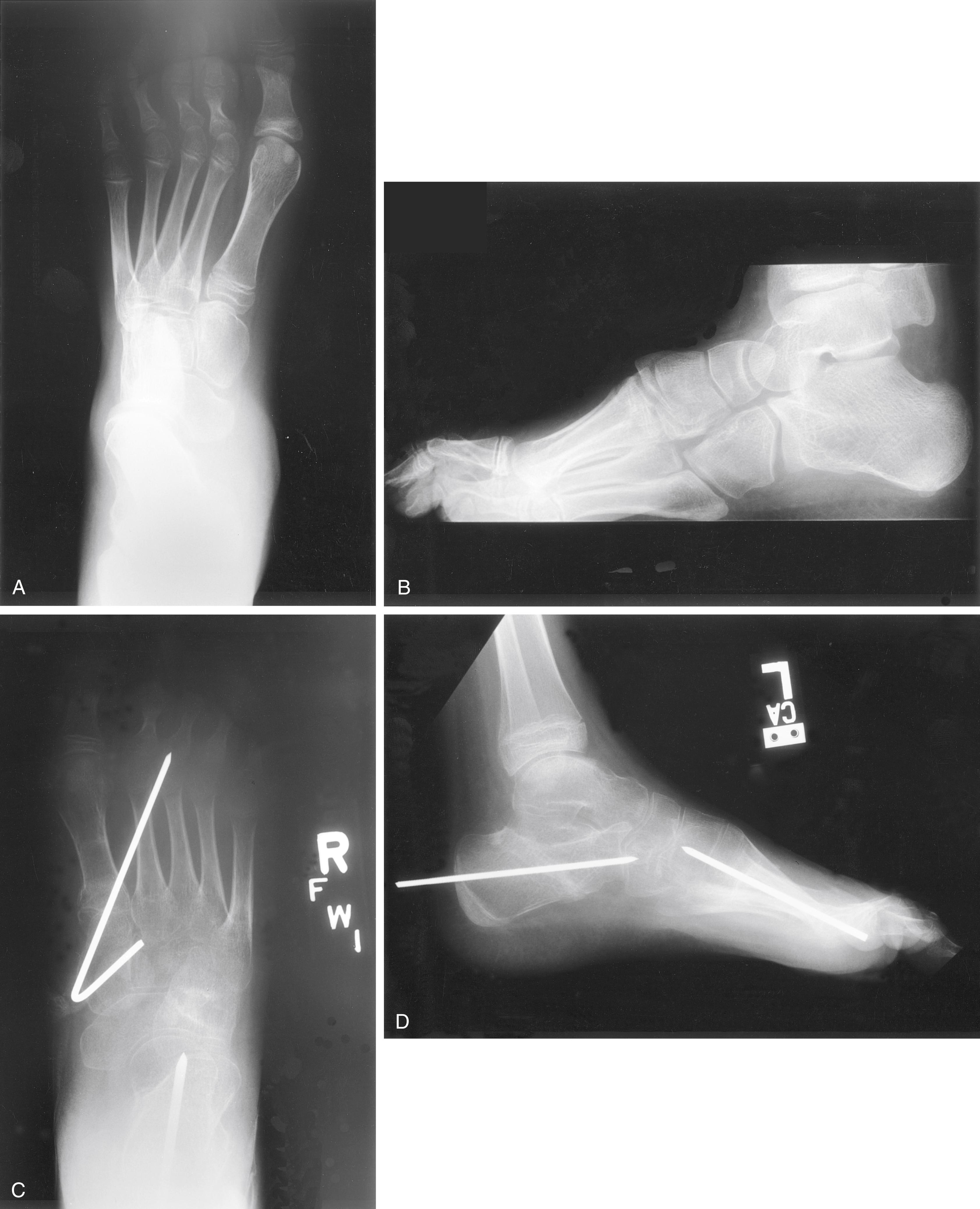
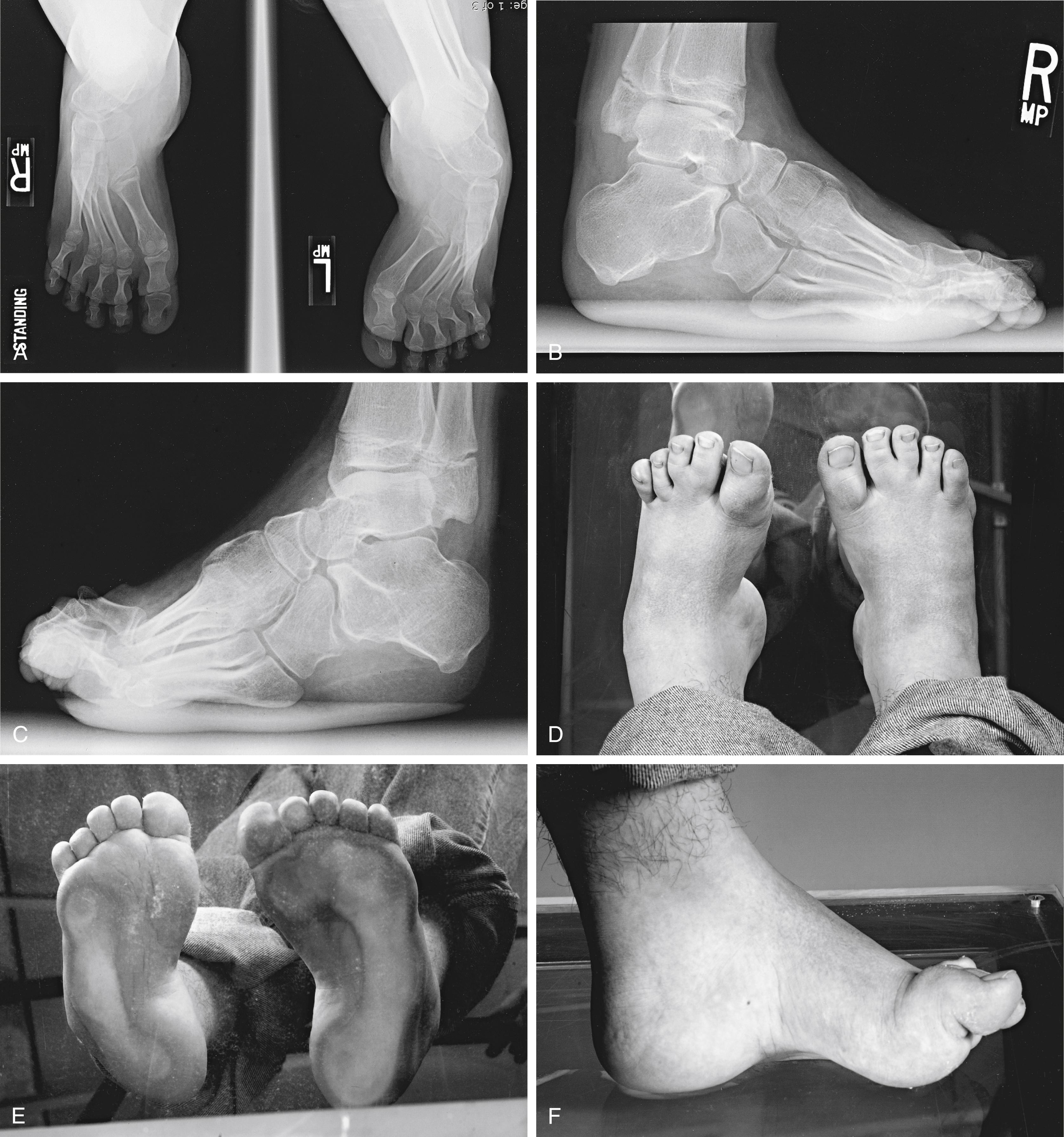
Despite frequent residual deformity and poor objective results, patient satisfaction with triple arthrodesis has been reported to be high (85%–95%) at intermediate and long-term follow-up. Long-term follow-up studies have found deteriorating results, likely because of progressive weakness and degenerative changes in a neighboring joint, especially the ankle joint. c
c References , , , , , .
Cavus feet in CMT are difficult to treat because the progressive neuropathy leads to a significant rate of recurrence of deformity after all forms of surgery. , A long-term follow-up study (26 years) of 25 adults who were treated for flexible cavovarus deformities with first metatarsal osteotomy and selected muscle transfers has reported that degenerative changes and reoperations were less frequent than after triple arthrodesis, even though almost all patients had recurrence of some hindfoot varus.
Patients with CMT often walk on their toes, and it is tempting to perform an Achilles tendon lengthening procedure in these patients. It is important to note that the forefoot is in equinus in CMT and the calcaneus usually is not, as evidenced by lack of calcaneal plantar flexion or normal calcaneal pitch on standing lateral radiographs of the foot. Therefore, lengthening of the Achilles tendon is not advised. In addition, when a plantar release is performed, a cast is used to maintain dorsiflexion of the forefoot. Manipulating the foot into dorsiflexion in the presence of a surgically lengthened Achilles tendon usually leads to overlengthening of the Achilles tendon and loss of correction of the forefoot equinus.
Weakness in the ankle dorsiflexors also leads to the development of claw toes because the intrinsic muscles are paralyzed and contracted and the toe extensors are recruited to help dorsiflex the ankle. When the condition is symptomatic, a Jones transfer of the extensor tendons of the great and lesser toes can help relieve pain on the dorsum of the toes. The long toe extensors are inserted through bone into the necks of the metatarsals so that they help dorsiflex the ankle rather than clawing the toes. Fusion of the IP joint of the great toe and of the proximal IP joints of the lesser toes helps prevent flexion deformity of the toes and should be done concomitantly with extensor tendon transfer.
A second orthopaedic problem seen in patients with CMT is hip dysplasia ( Fig. 34.9 ). , , It has been proposed that subtle weakness in the proximal musculature leads to progressive dysplasia of the hip. Although there are rare cases of hip instability in newborns with CMT, subluxation and acetabular dysplasia are usually asymptomatic until adolescence, when pain and gait abnormalities may occur. , , The dysplasia in CMT has been shown to be greater than that in an age-matched cohort of developmental dysplasia of the hip (DDH) patients. Early recognition and appropriate treatment are essential to avoid serious morbidity associated with the condition.
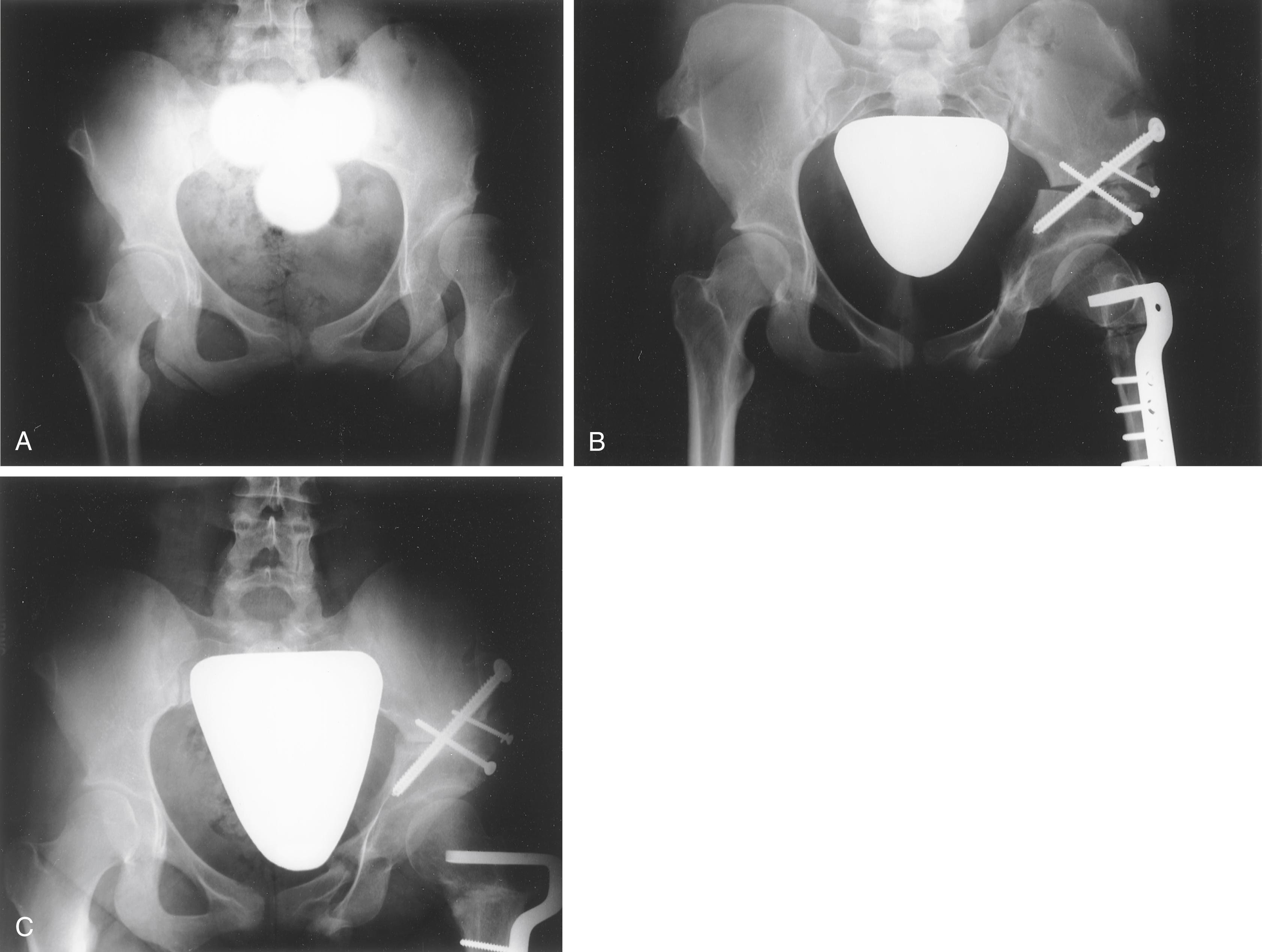
Surgical treatment, consisting of varus osteotomy of the femur or an acetabular redirectional osteotomy such as the Steel osteotomy or Bernese periacetabular osteotomy, has been useful in these patients in our practice. The treatment of teenagers with CMT requires correction of the acetabular and femoral components of the dysplasia and is similar to the treatment of adolescent idiopathic hip dysplasia outlined in Chapter 13 ( Fig. 34.10 ). The Bernese periacetabular osteotomy is an effective treatment for dysplasia in CMT but has a higher complication rate compared to the treatment of DDH. , The Bernese periacetabular osteotomy is an effective treatment of the acetabular dysplasia in the CMT population but has been found to have a higher complication rate compared to treatment of DDH, which may be associated with a higher rate of major and minor complications.
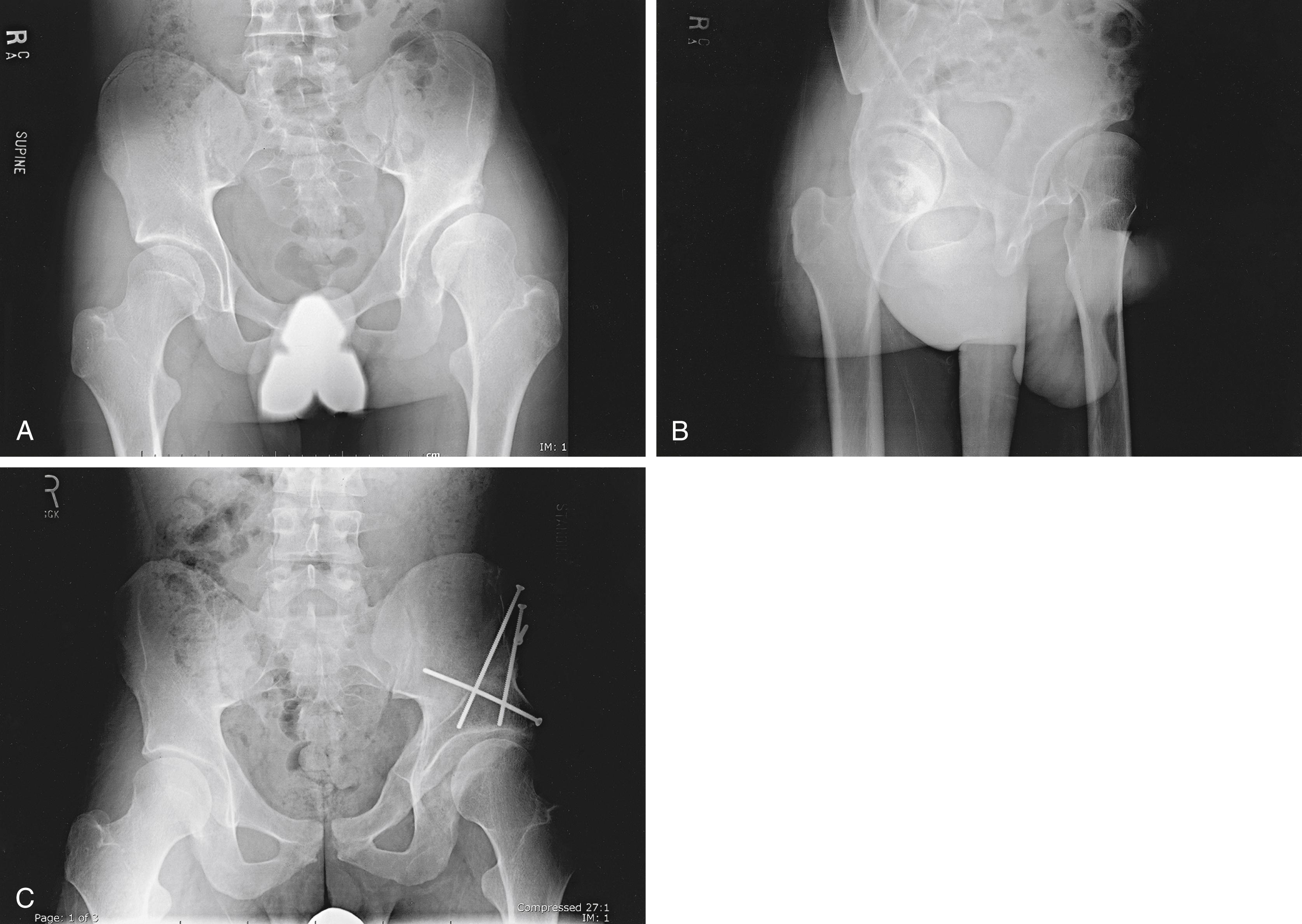
Scoliosis is seen in up to 37% of adolescents with CMT. Curves may resemble idiopathic curves in location but usually have increased thoracic kyphosis, unlike idiopathic scoliosis, which is typically lordotic ( Fig. 34.11 ). , There is also an increased incidence of left-sided thoracic curves in patients with CMT. Patients at highest risk for scoliosis are girls and those with CMT-1.
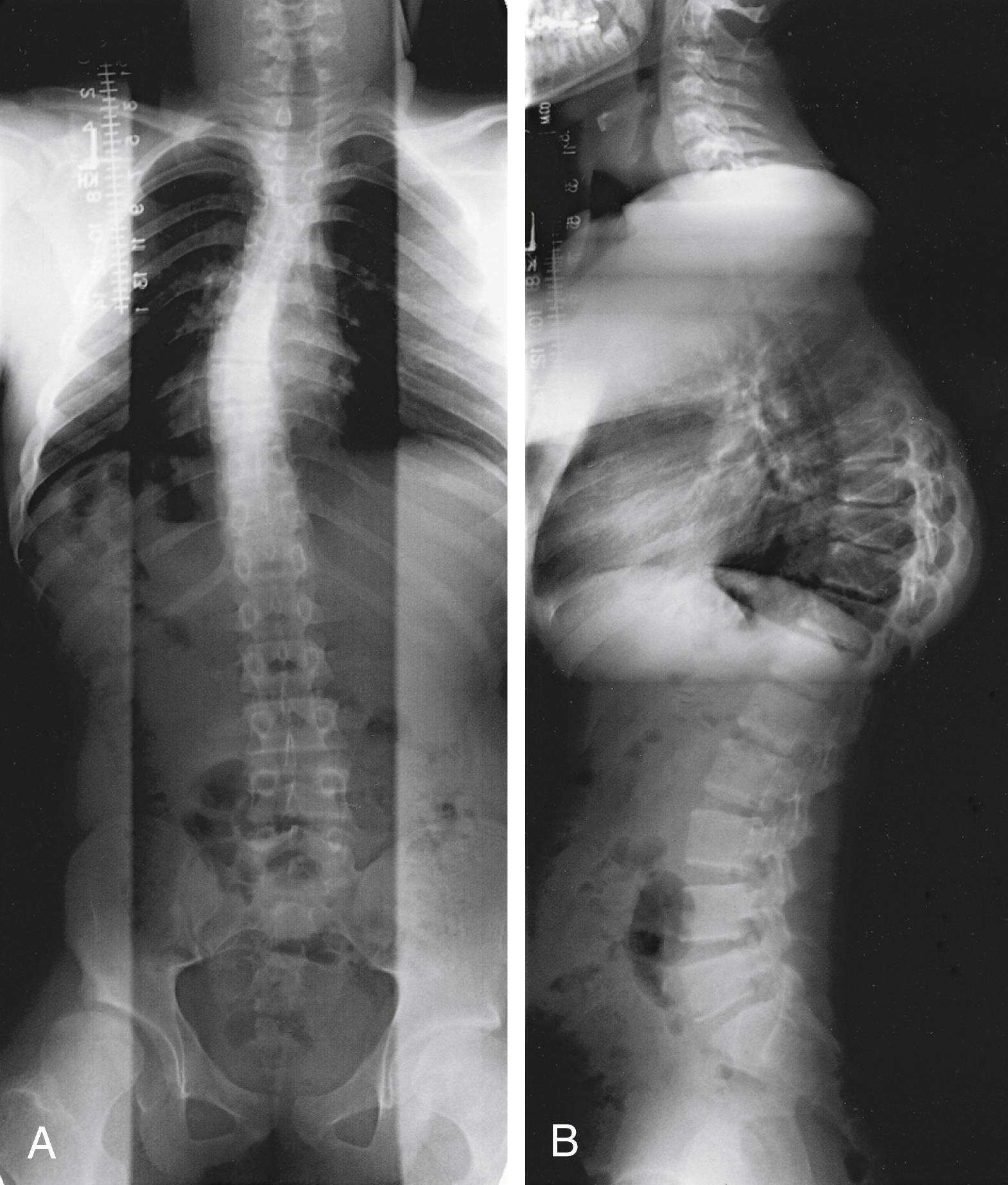
Orthotic management is rarely successful, and the prescription of a spinal orthosis should be considered in view of the patient’s other orthotic needs and ambulatory abilities. Posterior spinal fusion surgery may be required if orthotic management fails and the curves are progressive. Spinal cord monitoring of somatosensory-evoked potentials is usually impossible because of the peripheral neuropathy, so an intraoperative wake-up test may be necessary in patients with sufficient lower extremity strength. , Surgical fusion does not appear to be associated with a high rate of complications in patients with CMT, but a long instrumented posterior fusion is usually necessary. A subset of patients with CMT may have thoracic hyperkyphosis without scoliosis.
Hand involvement also occurs in patients with CMT, but intrinsic muscle atrophy and weakness usually become symptomatic later in the course of the disease. The onset of hand symptoms can occur in the first decade or as late as 30 years of age. The appearance of hand involvement may lag behind the appearance of lower extremity symptoms by 8 years; however, one study has found that hand involvement is present in all children with CMT-1A, even in its earliest stages. A delay in the recognition of hand problems may delay rehabilitation, which becomes more difficult with age because of worsening of day-to-day problems, such as poor handwriting, weakness, pain, and sensory symptoms. Approximately 75% of children have only mild hand involvement, 20% have hand problems severe enough to require daily rehabilitation, and approximately 5% have problems so severe that independence in activities of daily living (ADLs) is compromised. Quantitative testing of hand function has been described using a sensor-engineered glove test (SEGT). Patients with significant upper extremity weakness are at risk for weakness of the respiratory muscles as well.
Intrinsic weakness with clawing of the ring and small digits occurs first. Intrinsic paralysis of muscles innervated by ulnar and median nerves is common, whereas muscles innervated by the radial nerve are usually spared. Weakness of the forearm musculature innervated by median and ulnar nerves also occurs.
Become a Clinical Tree membership for Full access and enjoy Unlimited articles
If you are a member. Log in here